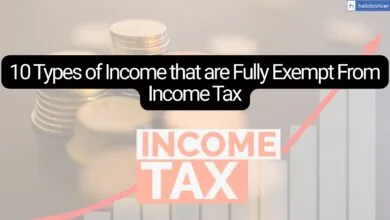How NIL Tax upto Rs.12 Lacs will boost Economy?

| Get instant news updates: Click here to join our Whatsapp Group |
The Government of India had increased ‘Nil tax’ slab from Rs 2.5 lakh in 2014 to Rs 7 lakh in 2023. However, the Government continued to have 2-tax regime (Old and New Tax Regime) and taxpayers could choose the regime as per his/her income and deductions. Around 78% of the returns filled under the Individual Income Tax (IT) are under the new tax regime.
The Government recently proposed a big income tax relief in the Union Budget 2025-26 in the new tax regime. The proposals were:
- No income tax burden for income levels up to Rs 12 lakh (i.e. average income of Rs 1 lakh per month other than special rate income such as capital gains) under the new regime
- This limit will be Rs 12.75 lakh for salaried taxpayers, due to standard deduction of Rs 75,000.
- Slabs and rates are being changed across the board to benefit all taxpayers
The new tax slabs now start at a higher income level (Rs.4 Lacs), allowing more people to benefit from the reduced rates. The increase in the income threshold means that middle-income earners will see a direct reduction in their tax liabilities.
| Tax slabs | Tax rate | Approximate Tax Payers (in Lakh) | Total tax savings (in Crore) | Total tax saving per tax payer (in Rs) | Total boost to consumption (in Rs Crore) using marginal propensity to consume / mpc of 0.7 |
|---|---|---|---|---|---|
| <= 4L | Nil | – | – | – | – |
| 4L–8L | 5% | 372.8 | 11,222 | – | 37,405 |
| 8L–12L | 10% | 112.0 | 43,080 | 38,455 | 1,43,600 |
| 12L–16L | 15% | 42.2 | 11,589 | 27,449 | 38,631 |
| 16–20L | 20% | 19.4 | 13,009 | 67,000 | 43,363 |
| 20L–24L | 25% | 9.5 | 9,415 | 98,650 | 31,384 |
| >=24L | 30% | 9.8 | 10,788 | 1,10,000 | 35,960 |
| Total | 565.8 | 99,103 | 3,30,344 |
This new tax structure is expected to benefit approximately total 5.65 crore taxpayers (above Rs 4 lakh tax slab) with total tax savings amounting to Rs 1 lakh crore, with maximum benefits accrued to people in 8L–12L income bucket. This could significantly stimulate economic activity and will ultimately contribute to more vibrant economy, encouraging sustainable growth and improving overall economic well-being.
The Rs 3.3 lakh crores is expected to flow into key sectors such as consumer goods, healthcare, education, and housing. This incremental spending over and above the base line spending is likely to drive demand in these sectors.
Break-up of Consumption Boost
Food Item
| Food Item | Rs Crore |
|---|---|
| Cereal | 12342 |
| Pulses And Pulse Products | 4026 |
| Sugar & Salt | 1881 |
| Milk And Milk Products | 23727 |
| Vegetables | 13596 |
| Fruits (Fresh + Dry) | 12771 |
| Egg, Fish & Meat | 11748 |
| Edible Oil | 6006 |
| Spices | 7590 |
| Beverages, Processed Food, Etc. | 37257 |
| Food Total | 130944 |
Non-Food Item
| Non-Food Item | Rs Crore |
|---|---|
| Pan, tobacco & intoxicants | 7821 |
| Fuel and light | 18447 |
| Toilet articles & other household consumables | 16995 |
| Education | 19701 |
| Medical (non-hospitalization) | 12837 |
| Conveyance | 27918 |
| Consumer services | 18876 |
| Entertainment | 5841 |
| Rent | 21714 |
| Clothing & bedding | 15840 |
| Footwear | 2838 |
| Durable goods | 22671 |
| Non-food Total | 199056 |
The Union Budget 2025-26 has also announced the extension of the time limit to file the updated return (ITR-U) from its current timeline of 24 months to 48 months.
In her budget speech, Hon’ble Finance Minister said that “nearly 90 lakh taxpayers voluntarily updated their incomes by paying additional tax. Taking this trust further, I now propose to extend the time limit to file updated returns for any assessment year.”
In addition to boosting household savings, the increased consumption of ₹3.3 lakh crore, driven by the new tax relief, is expected to significantly raise indirect tax collections, especially through the Goods and Services Tax (GST).
Assuming an average GST rate of 12%, this higher consumption could generate around ₹40,000 crore in indirect tax revenue. Out of this, ₹20,000 crore would go to the states, as per the existing revenue-sharing mechanism between the Centre and the states.
Furthermore, states receive 41% of the Central share of taxes. So, from the ₹20,000 crore collected by the Centre, about ₹8,000 crore would also be transferred to states. This means the total gain for states would be approximately ₹28,000 crore under the new tax system.
This increase in indirect tax revenues will strengthen government finances and allow for higher public spending, creating a positive cycle of economic growth. The expected rise in consumption will also benefit key sectors such as:
- Fast-Moving Consumer Goods (FMCG)
- Healthcare
- Entertainment
- Textiles
- Automobiles
- Real Estate
